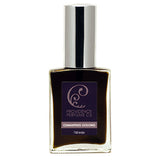Pantone Perfumes: A Guide For Creating Colorful Perfumes
By Charna from Providence Perfume Co., 100% natural perfume
Lady Gaga and I have precisely one thing in common: a black perfume in our roster. According to a recent press release, Gaga is launching a new black hued perfume called Fame which morphs from black to clear when sprayed. Hmmm, the wonders of modern chemistry? My perfume is nearly black (and stays that way) from the addition of lots of delightful dark essences such as oakmoss and black tea.


I've noticed a slew of colored perfumes being launched by the mainstream perfume industry of late and it pleases me immensely. This is a trend I can get behind. If there's one thing we natural perfumers do well it's colored perfumes! Now to be fair, these mainstream perfumes are artificially colored. However, nature provides a wide spectrum of colors for the natural perfumer to paint with. In fact, it's often difficult to create a natural perfume that isn't colored. As a perfumer I made a conscious decision to use any essence I desired when creating my line, regardless of how its addition effected the final color of the perfume. If I were to limit myself to using clear oils and absolutes I'd be left with only a handful of essences to work with. I wish to expand, not reduce my palette. This meant I would have accept that my natural perfumes were sometimes dark brown, or black or green when filtered.
Despite the fact that I had accepted these colored perfumes, I wondered how potential customers would react. Would consumers be less likely to purchase my Osmanthus Oolong eau de parfum because it was a dark gray color? Would the jade tone of Tabac Citron quell sales? My line has a distinct voice and color; perfumes so very different than the mainstream perfume industry. Artisanal fragrances. Perfumes made in small batches, by hand using incredibly rare, expensive natural essences that just so happen to be brightly colored. I'm happy to report that little fuss and few comments have been made about the colors of my fragrances. I expected the colors of the perfumes to be more off putting to the consumer than they seem to be. Acceptance! I have been asked on occasion if I dye my perfumes, to which I reply, "No, Mother Nature does."

As for me? I'm drawn to the mystery of a dusky scent. I'm tired of girly fruity floral scents. Hygienic clear bottles of scent hold no promise for me. Be gone era of clean, clear perfumes meant to evoke purity. I'm a vintage perfumista at heart. Bring on the deep, dark, richness of amber colored perfumes! While Estee Lauder's Youth Dew may not be my favorite scent, the fascination I feel when gazing upon it's dark liquid is palpable. Without even a sniff, Youth Dew makes it apparent that it's rich and deep and resinous. What secrets are locked inside that dark brown nectar?
So, along these lines I've created a quick perfume color guide. The following botanical essences possess serious color saturation. Adding more than a few drops will color a perfume quickly. In you've ever wondered why or how a natural perfume obtained it's hue read on.
GREEN: lavender absolute, lavender seville absolute, green tea absolute, violet leaf absolute, tobacco absolute, mint absolute, sweet clover absolute, rooibos (red tea) absolute, fir balsam absolute, geranium absolute, rosemary and basil absolutes.
BLUE: blue tansy, chamomile
ORANGE: rose absolute, pink lotus absolute, tuberose absolute, boronia absolute, immortelle absolute.
YELLOW: genet (broom) absolute, jasmine grandiflorum absolute, saffron absolute,
BROWN/BLACK: black tea absolute, cocoa absolute, coffee, angelica absolute, oakmoss absolute, cedarmoss, cedarwood absolute, vanilla absolute, labdanum.
Wishing you technicolor perfumed dreams.




1 comment:
Perfume and color. Two of my favorite things. I too like the colors of natural perfumes and I never realized that anyone would ever have a problem with the color. I'm totally with you on the old school perfumes and both rich, deep colors and scents. I remember Youth Dew and it's rich, brown color. Most perfumes from my youth had at least some color(most were gold,yellow,amber, and sometimes green;just like our natural perfumes)
In the beginning of my experiences with using natural essences for perfumes I too didn't really care what the end color of the blend turned out to be. I figured it would be some shade of the aformentioned colors and that was that. But over time I've been wanting to experiment with making perfumes specific colors. I've been dying to create a blue or aqua perfume, but I've been disappointed in the results. It seems the blue chamomile eventually turns green! I've also been thinking about purple,pink, and magenta perfumes too! There is a brand of natural food dyes derived from beets, purple cabbage, turmeric, etc. called India Tree and I was considering using those. The trick is finding colorless essences so the desired color is kept pure. So those are the ideas running around in my head.
I get black by using a base of one of my purple fruit tinctures(blackberry or blueberry), with dark brown essences and blue chamomile. I have three black perfumes; Black Cat, Witchcraft, and Pooka.
Post a Comment